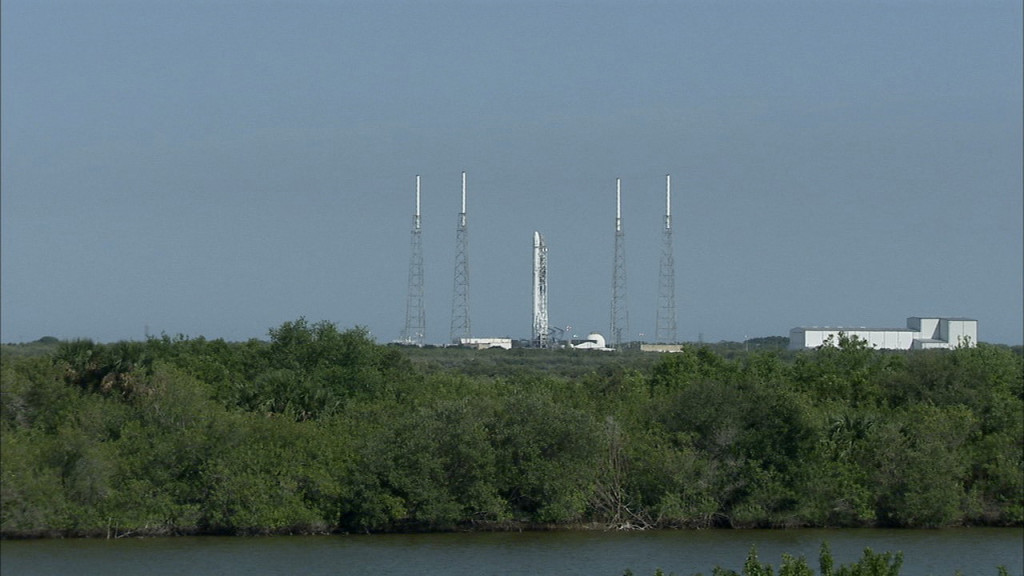The Falcon 9’s climb continues to go smoothly. Actual launch time was 4:43:31.000.
Month: April 2016
First Stage Burn Complete; Second Stage Takes Over
The Falcon 9 rocket’s nine first-stage Merlin engines cut off on time, shortly followed by stage separation and ignition the vehicle’s second-stage engine. The payload fairing has been jettisoned.
Falcon 9 Passing Max Q
The Falcon 9 rocket is passing through the area of maximum aerodynamic pressure commonly known as Max Q.
A rapid-fire sequence of staging events takes place in about a minute and a half with the shutdown of the first-stage engines, separation of the first stage and ignition of the second stage’s single engine.
Liftoff!
Liftoff! The SpaceX Falcon 9 rocket is climbing up and away from Florida’s Space Coast, carrying “science for today and deep space exploration for tomorrow,” in the words of Launch Commentator George Diller.
One Minute and Counting
The strongback now is fully retracted, Falcon 9 and Dragon are on internal power, and the launch director has given the final approval for launch.
During the next minute, the Falcon 9 flight computer will start its final round of prelaunch checks while the rocket’s propellant tanks come up to flight pressure.
Three Minutes and Counting
The gantry-like strongback support structure is retracting away from the Falcon 9 rocket.
Eight Minutes until Launch
Countdown and Ascent Highlights
Here’s a look ahead at the remaining countdown milestones and the sequence of events during the Falcon 9’s climb to orbit:
Hour:Minute:Second – Event
00:10 – Falcon 9 begins engine chill prior to launch
00:07 – Dragon to internal power
00:02 – Range Control Officer (USAF) verifies range is go for launch
00:01:30 – SpaceX Launch Director verifies go for launch
00:01 – Command flight computer to begin final prelaunch checks
00:01 – Pressurize propellant tanks
00:00:03 – Engine controller commands engine ignition sequence to start
00:00:00 – Falcon 9 liftoff
00:01:11 – Vehicle goes supersonic
00:02:30 – 1st stage main engine cutoff (MECO)
00:02:34 – 1st and 2nd stages separate
00:02:41 – 2nd stage engine starts
00:10 – 2nd stage engine cutoff (SECO)
00:10:30 – Dragon separates from 2nd stage
00:12 – Dragon’s solar arrays deploy
02:20 – Dragon’s Guidance, Navigation and Control bay door opens
What’s on Board? Science and Tech with Big Implications
The SpaceX Dragon capsule secured atop the Falcon 9 rocket measures 12 feet wide and 23.6 feet long. Tucked inside are 6,913 pounds of cargo, including more than 250 science and research investigations planned for use during the space station’s Expeditions 47 and 48. These investigations include a mix of commercial and academic payloads aimed at advancing NASA’s journey to Mars while making discoveries off the Earth that can benefit life on Earth.
For more information on the specific payloads flying on SpaceX CRS-8, check out this in-depth overview.
Also catching a ride to the station today is the Bigelow Expandable Activity Module, or BEAM, that will attach to the space station and demonstrate expandable in-space habitat technology. Once attached to the station, the BEAM will expand to roughly 13 feet long and 10.5 feet wide, providing a large-volume area in which astronauts will periodically retrieve sensor data and assess the module’s condition during its two-year test mission.
Tanking Operations Begin
Liquid oxygen and RP-1 fuel are starting to flow into the Falcon 9 rocket’s first- and second-stage propellant tanks and the terminal countdown has started.
The Falcon 9 — named after the Millennium Falcon spacecraft from the Star Wars film series — stands 229 feet tall and measures 12 feet wide. Its nine first-stage Merlin engines generate a combined 1.53 million pounds of thrust at liftoff.

